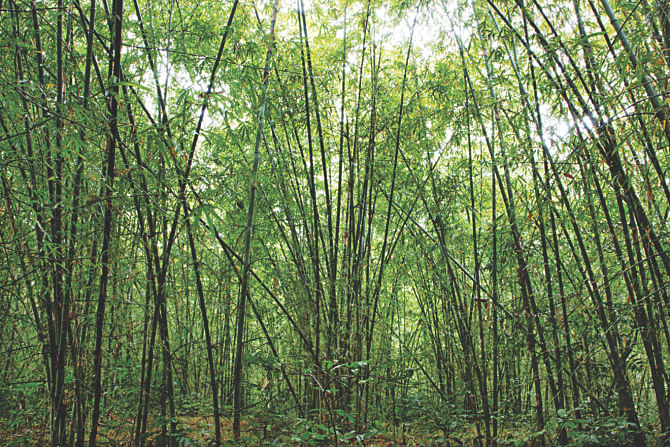Bamboo
Bamboo

One day, while working on my photobook on the natural beauty of Sylhet, I walked into a grove of bamboo adjacent to the highway in Habiganj. Soon I found myself immersed in a forest of impossibly green and slender trees that grew this way and that, often intersecting at the top. The beauty of the trees left a lasting impression on me.
The group of plants known as bamboo belongs to the larger grass family. There are about 1500 species of bamboos worldwide of which Bangladesh boasts around two dozen. While the grass family has influenced human civilization like no other plant family giving us rice, sugarcane, wheat and corn, bamboos have made their own mark by being useful. In Bangladesh, for example, bamboos are used for house construction, scaffolding, shelving, ladders, mats, baskets, fencing, tool-handles, pipes, toys, fishing rods, fishing traps, handicrafts and, last but not least, for cooking chunga pitha.
It turns out that bamboo plants have some unusual properties. They flower rarely (at intervals of 65 to 120 years) but when they do, all bamboos of the same grove flower together. Further, bamboos grown from cloning also flower in synchronization with their parent grove.
Bamboos are also some of the fastest-growing plants on the planet. Certain bamboo species have been known to grow 35 inches in twenty-four hours, but more realistically many species of bamboo can grow 1-2 inches in that period. In the growing season, individual shoots emerge from the ground and grow to full size in a single season of three to four months. Bamboos do not live very long – perhaps 5-8 years at most. They are usually ready for harvesting in three to five years. They grow best in warm weather, though some types of bamboo grow in Europe.
In Bangladesh several species of bamboo are prized for their strength and cultivated in villages. These include jai (bambusa vulgaris), barua (bambusa balcooa) and mittinga (bambusa jaintiana). Naturally occurring bamboos are dominated by the muli (melocanna baccifera) variety that grows all over Bangladesh.
One of the most interesting foods of the Sylhet region is chunga pitha, a smoked cake of sticky rice cooked inside the cavity of a bamboo over a fire. Traditionally dolu bamboo was used because it is thin, strong and there is a relatively long gap between its nodes. More recently, however, kali bamboo is used due to the unavailability of dolu. In fact restricted availability of this bamboo is one reason that prevents chunga pitha from becoming more widespread in Bangladesh.
Bamboo shoots are eaten in many places, including Bangladesh. However, because new shoots of are tender, animals also love them. The diet of the giant panda of China, for example, is 99% bamboo. The popularity of shoots is a problem. Monkeys, for example, cause great damage to bamboo production in many parts of Sylhet by eating the shoots before they can mature.
Due to urbanization and cultivation other types of trees, bamboo production in Bangladesh appears to be waning. However, it is worth our effort to grow, nurture and spread this magnificent plant.
www.facebook.com/tangents.ikabir